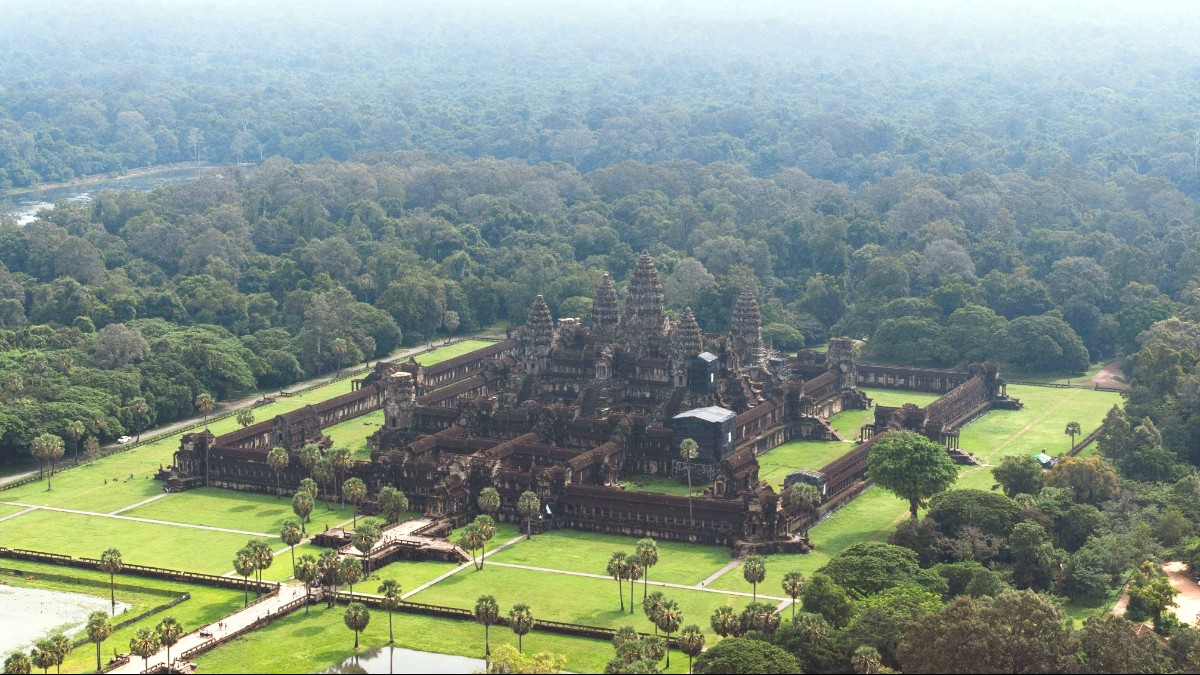
Cambodia
This is Angkor Wat, a place that captures the human spirit and imagination. It presents a journey back in time, displaying the grandeur of a civilization that shaped Southeast Asia. Visitors find themselves surrounded by awe-inspiring architecture and a deep sense of history. This guide aids your plan to this extraordinary monument and the wider Siem Reap region. Journey into Cambodia's heart, where history and natural beauty combine for a travel experience unlike any other.
This guide assists your visit to the extraordinary Angkor Wat monument and the wider Siem Reap region.
Prepare for an adventure into Cambodia's heart, where history and natural beauty blend for an unmatched travel experience.
Angkor Wat stands in the Siem Reap Province, a flat plain in northwestern Cambodia. This area is about 5.5 kilometers (3.4 miles) north of Siem Reap, the modern city that functions as the gateway for visitors.
Lush tropical forest surrounds the temple complex, creating a dramatic backdrop to the ancient stones. An intricate system of moats and reservoirs, remnants of the vast Khmer Empire's ingenious water management, further defines the landscape.
The Siem Reap River flows south through the province, eventually emptying into the immense Tonlé Sap lake.
Southeast Asia's largest freshwater body, Tonlé Sap holds an important role in the region's ecology and economy.
The climate is tropical monsoon, bringing distinct wet and dry seasons that shape the landscape.
Wet season brings verdant landscapes and stunning water reflections; dry season brings clear skies and comfortable exploration.
Khmer builders engineered vast water systems for irrigation, sustaining the ancient capital's population.
The flat topography around Angkor Wat made it an ideal location for a sprawling city and its associated agricultural lands. The Khmer builders engineered vast water systems to manage the monsoon rains, storing water for irrigation during the dry months.
This masterful control of water resources sustained the large population of the ancient capital.
Proximity to the Tonlé Sap lake ensured a ready supply of fish and was a natural defensive barrier and trade route.
The climate here is tropical monsoon, bringing distinct wet and dry seasons. This shapes everything from the vividness of the greenery to the ease of travel on local roads.
Angkor Wat is the world's largest religious monument by land area. Emperor Suryavarman II of the Khmer Empire began its construction in the early 12th century. He dedicated it to the Hindu god Vishnu, designating it a state temple and, perhaps, his mausoleum. The temple displays the pinnacle of classical Khmer architecture. Its design blends two basic plans of Khmer temple architecture: the temple-mountain and the later galleried temple. This fusion results in a majestic structure.
Over time, by the end of the 12th century, Angkor Wat gradually transformed into a Buddhist temple. This shift mirrors the evolving religious landscape of the Khmer Empire. It is the best-preserved temple within the vast Angkor archaeological site. The site extends over 400 square kilometers (154 square miles). It contains the magnificent remains of various capitals of the Khmer Empire, dating from the 9th to the 15th century. This sprawling complex is a testament to the power, artistic skill, and spiritual devotion of the Khmer people.
Angkor Wat is more than just an ancient ruin; it is an enduring symbol of Cambodia. Its iconic silhouette appears on the national flag, representing the nation's heritage and spiritual heart.
The temple's bas-reliefs narrate Hindu epics, historical events, and daily life, yielding insights into Khmer beliefs, warfare, and culture.
Designated an UNESCO World Heritage site in 1992, its recognition highlights its immense universal value and preservation efforts.
Visitors walk through centuries of history, witnessing a legacy of human achievement carved in stone.
A trip to Angkor Wat blends historical discovery and cultural immersion, with the Angkor Archaeological Park as its crown jewel.
The park encompasses many temples from the 9th to 15th centuries, each with its unique character and stories.
Originally a Hindu temple dedicated to Vishnu, Angkor Wat now operates as a Buddhist temple and remains a place of active worship.
The Angkor Archaeological Park holds numerous other temples from the same period, each with unique character.
The modern city of Siem Reap serves as a base with dining, shopping, and cultural activities.
Discover floating villages and the unique ecology of Southeast Asia's largest freshwater body, just south of Siem Reap.